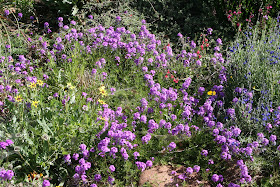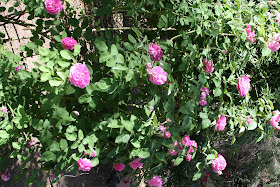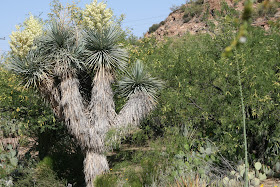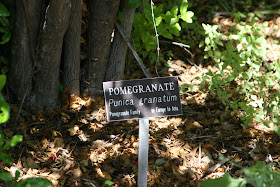2336 East Baseline Road
Mesa, AZ 85204
(480) 649-3394
The Mission of Boyce Thompson Arboretum is to instill in people an appreciation of plants through the fostering of educational, recreational, research, and conservation opportunities associated with arid-land plants
Artemisia (pronounced /ˌɑrtɨˈmiːziə/) is a large, diverse genus of plants with between 200 to 400 species belonging to the daisy family Asteraceae. It comprises hardy herbs and shrubs known for their volatile oils. They grow in temperate climates of the Northern Hemisphere and Southern Hemisphere, usually in dry or semi-dry habitats. The fern-like leaves of many species are covered with white hairs. Some botanists split the genus into several genera, but DNA analysis does not support the maintenance of the genera Crossostephium, Filifolium, Neopallasia, Seriphidium, and Sphaeromeria; three other segregate genera Stilnolepis, Elachanthemum, and Kaschgaria are maintained by this evidence.
Common names used for several species include mugwort, sagebrush, sagewort, and wormwood, while a few species have unique names, notably Tarragon (A. dracunculus) and Southernwood (A. abrotanum). Occasionally some of the species are called sages, causing confusion with the Salvia sages in the family Lamiaceae.
Most species have strong aromas and bitter tastes from terpenoids and sesquiterpene lactones, which exists as an adaptation to discourage herbivory. The small flowers are wind-pollinated.
Artemisia species are used as food plants by the larvae of a number of Lepidoptera species.
Within such religious practices as Wicca, both Wormwood and Mugwort are believed to have multiple effects on the psychic abilities of the practitioner. Because of the power believed to be inherent in certain herbs of the genus Artemisia, many believers cultivate the plants in a "moon garden".
Triangle-leaf bursage is a native plant of the Sonoran Desert and can be found throughout southwestern Arizona, USA, south into Sonora and Baja California, Mexico.
Triangle-leaf bursage can be found growing in upper and lower bajadas, lowland creosote growths and desert grasslands. It grows at altitudes of 1,000 to 3,000 feet on open flat, spaces, and steep, gravely hillsides. Triangle-leaf bursage prefers to grow in coarse soils with a high pH where rain percolates quickly and drains away. It is the dominant plant in the Upland Subdivision of the Sonoran Desert where it gets two rainy seasons. It is found growing with palo verde, mesquite, ironwood and mixed varieties of cacti.
For a desert plant it has a short life-span, only 50 years. Its most significant function is as a "nurse plant" for other species. Because it prefers to grow in open, sunny areas, it is one of the first plants to populate an empty space too hot for other seedlings. Once it is established, it provides a microhabitat for the seedlings of other species and protects them from herbivores with its tangle of branches. In time the area becomes populated with many different species of desert plants.
The triangle-leaf bursage is a member of the Sunflower family and a cousin of common ragweed.
Sambucus (elder or elderberry) is a genus of between 5 and 30 species of shrubs or small trees in the moschatel family, Adoxaceae. It was formerly placed in the honeysuckle family, Caprifoliaceae, but was reclassified due to genetic evidence. Two of its species are herbaceous.
The genus is native in temperate-to-subtropical regions of both the Northern Hemisphere and the Southern Hemisphere. It is more widespread in the Northern Hemisphere; its Southern Hemisphere occurrence is restricted to parts of Australasia and South America.
The leaves are pinnate with 5–9 leaflets (rarely 3 or 11). Each leaf is 5–30 cm (2.0–12 in) long, and the leaflets have serrated margins. They bear large clusters of small white or cream-colored flowers in late spring; these are followed by clusters of small black, blue-black, or red berries (rarely yellow or white).
The flowers of Sambucus nigra are used to produce elderflower cordial. The French, Austrians and Central Europeans produce elderflower syrup, commonly made from an extract of elderflower blossoms, which is added to pancake (Palatschinken) mixes instead of blueberries. People throughout much of Central, Eastern, and Southeastern Europe use a similar method to make a syrup which is diluted with water and used as a drink. Based on this syrup, Fanta markets a soft drink variety called "Shokata"[3] which is sold in 15 countries worldwide. In the United States, this French elderflower syrup is used to make elderflower marshmallows.
Wines, cordials and marmalade have been produced from the berries. In Italy (especially in Piedmont) and Germany the umbels of the elderberry are batter coated, fried and then served as a dessert or a sweet lunch with a sugar and cinnamon topping. A key ingredient in "purple juice".
Chilopsis is a genus of flowering plant, containing a single species, Chilopsis linearis. It is a small tree native to the southwestern United States and Mexico. Despite the common name Desert-willow, given because of its willow-like leaves, it is actually a member of the bignonia family, Bignoniaceae. It is commonly seen in washes and along riverbanks at elevations below 1500 m in its range.
It is cultivated for its large showy flowers, and tolerance of hot, dry climates. Although the natural growth is a very irregular shape, it can be readily pruned into a conventional tree shape. A number of cultivars have been selected, some (e.g. 'Rio Salado') with flowers of a dark and rich purple or magenta shades.
Gutierrezia is a genus of flowering plants in the sunflower family. Plants of this genus are known generally as snakeweeds or matchweeds. There are about 25 species found in North and South America. These plants contain chemical compounds which can be toxic to livestock and some are considered weeds. They bear small yellow daisylike flowers.
Vachellia farnesiana, previously known as Acacia farnesiana, commonly known as Needle Bush, is so named because of the numerous thorns distributed along its branches. The native range of V. farnesiana is uncertain. While the point of origin is Mexico and Central America the species has a pantropical distribution incorporating Northern Australia and Southern Asia. It remains unclear whether the extra-American distribution is primarily natural or anthropogenic. It is deciduous over part of its range, but evergreen in most locales. The species grows to a height of up to 8 metres (26 ft) and has a life span of about 25–50 years
Jojoba, pronounced /həˈhoʊbə/ ( listen), (Simmondsia chinensis) is a shrub native to the Sonoran and Mojave deserts of Arizona, California, and Mexico. It is the sole species of the family Simmondsiaceae, placed in the order Caryophyllales. It is also known as goat nut, deer nut, pignut, wild hazel, quinine nut, coffeeberry, and gray box bush. Jojoba is grown commercially for its oil, a liquid wax ester, expressed from the seed. The plant has also been used to combat and prevent desertification in the Thar Desert in India.
Jojoba is grown for the liquid wax (commonly called jojoba oil) in its seeds. This oil is rare in that it is an extremely long (C36-C46) straight-chain wax ester and not a triglyceride, making jojoba and its derivative jojoba esters more similar to human sebum and whale oil than to traditional vegetable oils.
Jojoba oil is easily refined to be odorless, colorless and oxidatively stable, and is often used in cosmetics as a moisturizer and as a carrier oil for specialty fragrances. It also has potential use as both a biodiesel fuel for cars and trucks, as well as a biodegradable lubricant.
Mormon Tea
A branched broomlike shrub growing up to 4 feet tall, with slender, jointed stems. The leaves are reduced to scales and grow in opposite pairs or whorls of three and are fused for half their length. Male and female flowers, blooming in March and April, are borne on separate plants in conelike structures. They are followed by small brown to black seeds.
A branched broomlike shrub growing up to 4 feet tall, with slender, jointed stems. The leaves are reduced to scales and grow in opposite pairs or whorls of three and are fused for half their length. Male and female flowers, blooming in March and April, are borne on separate plants in conelike structures. They are followed by small brown to black seeds.
Early Mormon settlers, who abstained from regular tea and coffee, drank the beverage made from this plant. A handful of green or dry stems and leaves were placed in boiling water for each cup of tea desired. It was removed from the fire and allowed to steep for twenty minutes or more. To bring out the full flavor, a spoon of sugar or some strawberry jam was added depending on individual taste.
Other white settlers used a very strong tea of the plant for the treatment of syphilis and other venereal disease, and as a tonic. It was standard fare in the waiting rooms of whorehouses in early Nevada and California. It was said to have been introduced by a Jack Mormon who frequented Katie’s Place in Elko, Nevada during the mining rush of the last century.
Opuntia leptocaulis or Tasajo is an cylindrical evergreen Opuntia that is native from Arizona to Texas and southwest Oklahoma and as far south as northern Mexico. In nature, the plants can reach up to 5 feet (1.5m) tall with a 3 foot (1 m) spread. The cylindrical stems are 3/16 inches (~5 mm) thick; joints are anywhere from 1 inch (2.5 cm) to 12 inches (30 cm) long, becoming very woody with age. Spines are slender and usually one per areole, with lengths reaching from 0.75 to 2 inches (2-5 cm) long. In early spring, the new growth has numerous small deciduous leaves. These are great cacti for containers and they are hardy in the landscape in USDA zones 7-11
(e-keen-oo-KAY-ree-us tri-glow-chidi-A-tus) Echinocerens is from the Greek echinos, meaning "a hedgehog," and cereus meaning "a wax taper." These names refer to the plant's spiny resemblance to a hedgehog (or so the early Europeans thought) and the plant's shape, respectively. Triglochidialus means "three barbed bristles" and refers to the straight spines arranged in clusters of three. Also called claret cup cactus, after the reddish, cup-shaped flowers.
A small barrel-shaped cactus. Few to several hundred stems in a compact hemispheric clump or mound. The stems are mainly cylindrical, up to one foot long and one to two and one-half inches thick, and with nine or ten ribs. The central spines are straight or slightly curved and one to two inches long. Smaller radial spines arise from below the central spines at a sharp angle.
The misnamed century plant typically lives only 10 to 30 years. It has a spreading rosette (about 4 m/13 ft wide) of gray-green leaves up to 2 m (6.6 ft) long, each with a spiny margin and a heavy spike at the tip that can pierce to the bone. When it flowers, the spike with an cyme of big yellow flowers may reach up to 8 m (26 ft) in height. Its common name likely derives from its semelparous nature of flowering only once at the end of its long life. The plant dies after flowering, but produces suckers or adventitious shoots from the base, which continue its growth.
Cultivated varieties include the "marginata" with yellow stripes along the margins of each leaf, "medio-picta alba" with a central white band, "medio-picta aurea" with a central yellow band, "striata" with multiple yellow to white stripes along the leaves, and "variegata" with white edges on the leaves.
Uses
If the flower stem is cut without flowering, a sweet liquid called agua miel ("honey water") gathers in the heart of the plant. This may be fermented to produce the drink called pulque. The leaves also yield fibers, known as pita, which are suitable for making rope, matting, coarse cloth and are used for embroidery of leather in a technique known as piteado.
Agave nectar (also called agave syrup) is a sweetener commercially produced in Mexico from several species of agave, including the Blue Agave (Agave tequilana), Salmiana Agave (Agave salmiana), Green Agave, Grey Agave, Thorny Agave, and Rainbow Agave. Agave nectar is sweeter than honey, though less viscous.
Agave nectar syrup is produced in South Africa and the Mexican States of Jalisco, Michoacán, Guanajuato and Tamaulipas. Most is produced in Jalisco and the Eastern Cape Province of South Africa.
Agave Nectar sugar is only produced in South Africa from the Blue Agave Americana plant. The process of production is a closely guarded secret.
Agave nectar is 1.4 to 1.6 times sweeter than sugar. Agave nectar is often substituted for sugar or honey in recipes. Agave is commonly used as a Vegan alternative to honey in cooking. Because it dissolves quickly, it can be used as a sweetener for cold beverages such as iced tea.
Agave nectars are sold in light, amber, dark, and raw varieties. Light agave nectar has a mild, almost neutral flavor, and is therefore sometimes used in delicate-tasting foods and drinks. Amber agave nectar has a medium-intensity caramel flavor, and is therefore used in foods and drinks with stronger flavors. Dark agave nectar has stronger caramel notes, and imparts a distinct flavor to dishes, such as some desserts, poultry, meat, and seafood dishes. Both amber and dark agave nectar are sometimes used "straight out of the bottle" as a topping for pancakes and waffles. The dark version is unfiltered and therefore contains a higher concentration of the agave plant's minerals. Raw agave nectar also has a mild, neutral taste. It is produced at temperatures below 118 °F (48 °C) to protect the natural enzymes, so this variety is an appropriate sweetener for raw foodists.
Banksia grandis, commonly known as Bull Banksia, Giant Banksia or Mangite, is a common and distinctive tree in South West Western Australia.
Bull Banksia usually grows as a tree between 5 and 10 metres high, but may attain heights of up to 15 metres. It is also found in the form of a stunted, spreading shrub, near the south coast and whenever it occurs among granite rocks. Its trunks are short, stout and often crooked, with the rough grey bark characteristic of Banksia. The leaves are very distinctive; they are very large, being up to 45 cm long and 11 centimetres wide, and consist of a series of triangular lobes that go right back to the prominent midrib. Shiny dark green on top, they have a soft white tomentum underneath. New growth is a paler lime green and very attractive. Flowering is in Summer. The large cylindrical flower spikes, which can reach up to 35 cm high, are yellow, with a cream style. The "cones" shed their old flower parts early, so do not have the hairy appearance of the "cones" of many other Banksia species. Old cones are often varnished or cut and the typical banksia species used in decorative woodwork.
Green House
Yucca is a genus of perennial shrubs and trees in the agave family, Agavaceae. Its 40-50 species are notable for their rosettes of evergreen, tough, sword-shaped leaves and large terminal panicles of white or whitish flowers. They are native to the hot and dry (arid) parts of North America, Central America, South America, and the Caribbean. Early reports of the species were confused with the cassava (Manihot esculenta). Consequently, Linnaeus mistakenly derived the generic name from the Carib word for the latter, yuca. It is also colloquially known in the midwest United States as "Ghosts in the graveyard", as it is commonly found growing in rural graveyards and when in bloom the flowers appear as an apparition floating.
The toothpick cactus (Stetsonia coryne) is a species of cactus and the sole species of its genus (Stetsonia). The plant originates from the low northwest deserts of Argentina and Bolivia.
Stetsonia coryne grows to a height of 2.4-10 m tall. It has white blossoms in spring or summer
Echinocactus grusonii is a well known species of cactus native to central Mexico from San Luis Potosi to Hidalgo. Described by Heinrich Hildmann in 1891, it is popularly known as the Golden Barrel Cactus, Golden Ball or, amusingly, Mother-in-Law's Cushion. It belongs to the small genus Echinocactus, which together with the related genus Ferocactus, are commonly referred to as barrel cacti.
Despite being one of the most popular cacti in cultivation, it is rare and critically endangered in the wild.
Growing as a large roughly spherical globe, it may eventually reach over a meter in height after many years. There may be up to 35 pronounced ribs in mature plants, though they are not evident in young plants, which may have a knobbly appearance. Note: Younger Golden Barrels do not look similar to the mature ones. The sharp spines are long, straight or slightly curved, and various shades of yellow or, occasionally, white. Small yellow flowers appear in summer around the crown of the plant, but only after twenty years or so.
A man-made resevoir, supplies the arboretum with irrigation water. The lake has two ramadas that offer excellent views of the surrounding area. It is home to several different species of migratory waterfowl, and has been stocked by the state with two species of endangered native fish, the Gila Topminnow and the Desert Pupfish.
Castle on the Rocks,' built by Colonel William B. Thompson
Construction began in 1923, took 14 months to complete and cost $20,000 by some estimates," said Arboretum Director Mark Siegwarth. "The Colonel founded the Boyce Thompson Arboretum and donated his house and the surrounding property to the Arboretum in 1928. The Colonel passed away a few years later, in 1930. Picket Post Mansion was sold in 1946 to Walter and Ida Franklin of Globe for $40,000 as it became a financial burden to the Arboretum, then operated as a bed and breakfast. One of its more famous visitors was Admiral Richard Byrd's wife and two daughters in 1947, who stayed there as the Admiral was away on an expedition to the South Pole. Again, due to the cost of maintaining the Picket Post House, it changed hands again and was eventually was acquired by Rick and Tina Rose. Most people's memories of tours were probably during the Rose's ownership. On July 15, 2008, Arizona State Parks purchased the property to make the Arboretum whole once again.
Although renovations to restore the Picket Post House have not yet begun, the interest in the Picket Post House has led the Arboretum to open it for two weekends only to help raise funds for its operations," said Siegwarth. "The Arboretum generates over 90% of its own revenues. Without renovation and a larger staff, the Arboretum cannot keep Picket Post Mansion open, so do not miss this rare opportunity.
The toothpick cactus (Stetsonia coryne) is a species of cactus and the sole species of its genus (Stetsonia). The plant originates from the low northwest deserts of Argentina and Bolivia.
A Drain Pipe
A Bridge in the trees
A member of the Elm family, this bushy plant growths thickly and may reach 20'. In contrast to its sister plant the Netleaf Hackberry, its dark green leaves are evergreen, and their veins are not net-like (reticulate). Leaves are elliptical-to-oval (and not pointed); flowers are whitish and tiny, fruits yellow/orange and sweet in flavor. This bush grows in a wide variety of locations from 1500-3500', in washes, canyons, and even open desert (but more typically near occasional water sources).
The fruits of this plant are eaten by a variety of birds and other animals, and were also consumed by Native Americans. They have a tart-sweet flavor.
Desert Hackberry
Cool Cliff Side Walk
Pump House
Pulling water from a stream to Ayer Lake
A pomegranate (Punica granatum, pronounced /ˈpɒm.ɪ.græn.ət/) is a fruit-bearing deciduous shrub or small tree growing between five and eight meters tall. The pomegranate is mostly native to the Iranian Plateau and the Himalayas in north Pakistan and Northern India. It has been cultivated in the Caucasus since ancient times, and today, is widely cultivated throughout Iran, Azerbaijan, Afghanistan, India, Pakistan, Bangladesh, Iraq, Egypt, China, Burma, Saudi Arabia, Israel, the drier parts of southeast Asia, the Mediterranean region of Southern Europe, and tropical Africa. Introduced into Latin America and California by Spanish settlers in 1769, pomegranate is now cultivated in parts of California and Arizona for juice production.
In the Northern Hemisphere, the fruit is typically in season from September to February. In the Southern Hemisphere, it is in season from March to May.
The pomegranate is a very ancient fruit, mentioned in the Homeric Hymns and the Book of Exodus. Yet, it has still to reach mainstream prominence in the commercial markets of North America and the Western Hemisphere.
Mike Hites standing next to the pomegranate tree.
Society garlic is a clump-forming herbaceous perennial with narrow, grayish green leaves and large clusters of lavender or lilac flowers. The plant looks like an especially showy garlic or garlic chives plant. Society garlic has just 4-9 grasslike leaves, each about a foot long and a half-inch wide. The leaves grow straight up out of a swollen underground rhizome that looks like a corm or bulb. A single 2 ft (0.6 m) scape (flowering stalk) grows up from the center of the rosette of leaves. Atop the scape sits a large umbel (flower cluster in which all the pedicels (flower stems) originate from the same point) of sweet-scented lilac-pink flowers. The flowers are tubular, expanding to six pointed stars at their ends. They are a little less than an inch long and wide, and there are 8-20 of the dainty little flowers in each umbel. The blossoms are produced sporadically from early summer until late autumn. The leaves and rhizomes of society garlic smell like garlic, but the flowers are sweet, smelling like hyacinths, and some people say they are too sweet! The cultivar, 'Silver Lace' (a.k.a. 'Variegata') has larger flowers and leaves with cream stripes. 'Tricolor' has pink and white variegations.
The Clevenger House
Robert Clevenger lived near Superior in a stone house he had built for his famiy.
Katy’s Grandmas Oregano
Origanum Vulgare
Oregano (pronounced UK: /ɒrɨˈɡɑːnoʊ/, US: /əˈrɛɡənoʊ/) – scientifically named Origanum vulgare by Carolus Linnaeus – is a common species of Origanum, a genus of the mint family (Lamiaceae). It is native to warm-temperate western and southwestern Eurasia and the Mediterranean region.
Oregano is a perennial herb, growing from 20–80 cm tall, with opposite leaves 1–4 cm long. Oregano will grow in a pH range between 6.0 (mildly acid) and 9.0 (strongly alkaline) with a preferred range between 6.0 and 8.0. The flowers are purple, 3–4 mm long, produced in erect spikes. It is sometimes called wild marjoram, and its close relative O. majorana is then known as sweet marjoram.
Centranthus ruber, also called Valerian or Red valerian is a popular garden plant grown for its ornamental flowers. Other common names include Jupiter's Beard and Spur Valerian
Both leaves and roots can be eaten, the leaves either fresh in salads or lightly boiled, the roots boiled in soups. Opinions differ as to whether either make very good eating, however. Although it is sometimes reported to have medicinal properties, there is no basis for this view, which is almost certainly due to confusion with true Valerian.
Cymbopogon (lemongrass) is a genus of about 55 species of grasses, (of which the type species is Cymbopogon citratus) native to warm temperate and tropical regions of the Old World and Oceania. It is a tall perennial grass. Common names include lemon grass, lemongrass, barbed wire grass, silky heads, citronella grass,cha de Dartigalongue, fever grass, Hierba Luisa or Gavati Chaha amongst many others.
Lemongrass is commonly used in teas, soups, and curries. It is also suitable for poultry, fish, beef, and seafood. It is often used as a tea in African countries such as Togo and the Democratic Republic of the Congo and Latin American countries such as Mexico.
Lemongrass oil is used as a pesticide and a preservative. Research shows that lemongrass oil has anti-fungal properties
Yerba mansa or lizard tail (Anemopsis californica) is a perennial flowering plant within the family Saururaceae. It is the only species in the monotypic genus Anemopsis. It is native to southwestern North America. The conic white 'flowers' (actually reduced inflorescences, or pseudanthia) are borne in early spring, and are surrounded by 4-9 large white bracts. As it matures, the visible part of the plant develops red stains, eventually turning bright red in the fall.
Medicinal Uses
Yerba mansa is used as an antimicrobial, an antibacterial, and to treat vaginal candidiasis.
Yerba mansa is used to treat inflammation of the mucous membranes, swollen gums and sore throat. An infusion of roots can be taken as a diuretic to treat rheumatic diseases like gout by ridding the body of excess uric acid, which causes painful inflammation of the joints. Yerba mansa prevents the buildup of uric acid crystals in the kidneys which could causes kidney stones if left untreated. A powder of dried root can be sprinkled on infected areas to alleviate athlete's foot or diaper rash.
Yerba mansa is versatile, it can be taken orally as a tea, tincture, infusion or dried in capsule form. It can be used externally for soaking inflamed or infected areas. It can be ground and used as a dusting powder. Some people in Las Cruces, NM use the leaves to make a poultice to relieve muscle swelling and inflammation.
Lemon balm (Melissa officinalis), not to be confused with bee balm, Monarda species, is a perennial herb in the mint family Lamiaceae, native to southern Europe and the Mediterranean region. In England it may be known simply as "balm".
Lemon balm is often used as a flavouring in ice cream and herbal teas, both hot and iced, often in combination with other herbs such as spearmint. It is also frequently paired with fruit dishes or candies. It can be used in fish dishes and is the key ingredient in lemon balm pesto.
The crushed leaves, when rubbed on the skin, are used as a repellant for mosquitos.
Lemon balm is also used medicinally as a herbal tea, or in extract form. It is claimed to have antibacterial and antiviral properties (it is effective against herpes simplex).
It is also used as an anxiolytic, mild sedative or calming agent. At least one study has found it to be effective at reducing stress.
Salvia lavandulifolia (Spanish sage) is a small woody herbaceous perennial native to Spain and southern France, growing in rocky soil in Maquis shrubland, often found growing with Rosemary, Lavandula lanata, and Genista cinerea.
Salvia lavandulifolia grows one foot tall and wide, with a reclining habit and narrow, lanceolate, whitish-gray evergreen leaves that are less than 2 inches long. The leaves grow opposite each other on the stem and appear to grow in bunches. When the leaves are rubbed, oils give off a fragrance similar to rosemary. These oils are used for scenting soaps. The 1 inch long pale lavender flowers grow on short inflorescences, blooming for about one month in late spring and early summer. The flowering stems have very few flowers on widely spaced whorls. Some varieties have a dark calyx.
Strong orange-lemon citrus scent; flowers with deep pink faces; decorative growth with well-formed leaves; thick growth; slightly pyramidal.
Cool looking drinking fountain
Australian Outback Sheepherder's Cabin
Boyce Thompson Arboretum
Fouquieria splendens Engelm. is a desert plant of the southwestern United States and northern Mexico. Common names include ocotillo, desert coral, coachwhip, Jacob's staff, and vine cactus, although it is not a true cactus. For much of the year, the plant appears to be an arrangement of large spiny dead sticks, although closer examination reveals that the stems are partly green. With rainfall the plant quickly becomes lush with small (2-4 cm) ovate leaves, which may remain for weeks or even months.
Individual stems may reach a diameter of 5 cm at the base, and the plant may grow to a height of 10 m. The plant branches very heavily at its base, but above that the branches are pole-like and only infrequently divide further, and specimens in cultivation may not exhibit any secondary branches. The leaf stalks harden into blunt spines, and new leaves sprout from the base of the spine.
The bright crimson flowers appear especially after rainfall in spring, summer, and occasionally fall. Flowers are clustered indeterminantly at the tips of each mature stem. Individual flowers are mildly zygomorphic and are pollinated by hummingbirds and native carpenter bees.
Uses
Individual ocotillo stems are used as poles as a fencing material in their native region, and often take root to form a living fence.
Owing to light weight and an interesting pattern, these have been used for canes or walking sticks.
Flowers are collected, dried, and used for herbal tea.
Fresh flowers are used in salads and have a tangy flavor
The arboretum is located near milepost #223 on US Highway 60, a one-hour drive due east of Phoenix or about 90 minutes from the North side of Tucson via Oracle Road to highway 79 North past Florence to the crossroads with highway 60 -- then another 12 miles East on highway 60.
ADMISSION is $7.50 for adults and $3 for ages 5-12,
and free to children younger than age 5.
See You All At The Garden!




































































































Thanks for sharing this informative information about Yerba Mansa Powder with us. It's very helpful. Keep it up!
ReplyDelete